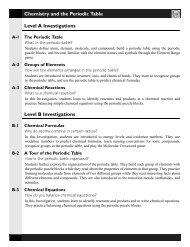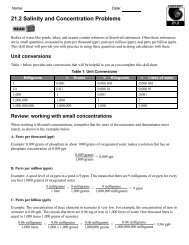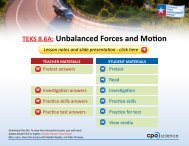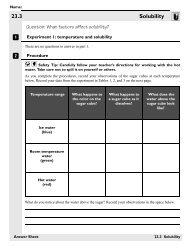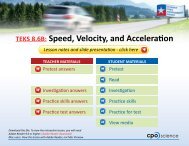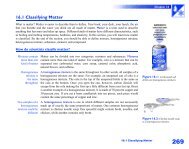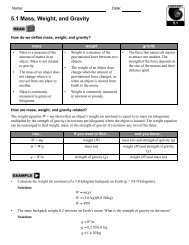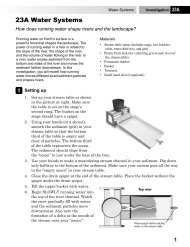PES Skill Sheets.book - CPO Science
PES Skill Sheets.book - CPO Science
PES Skill Sheets.book - CPO Science
You also want an ePaper? Increase the reach of your titles
YUMPU automatically turns print PDFs into web optimized ePapers that Google loves.
Name:<br />
Date:<br />
10.3 Pressure in Fluids<br />
10.3<br />
Have you ever wondered how a 1,500-kilogram car is raised off the ground in a mechanic’s shop? A hydraulic<br />
lift does the trick. All hydraulic machines operate on the basis of Pascal’s principle, which states that the pressure<br />
applied to an incompressible fluid in a closed container is transmitted equally in all parts of the fluid.<br />
In the diagram above, a piston at the top of the small tube pushes down on the fluid. This input force generates a<br />
certain amount of pressure, which can be calculated using the formula:<br />
Pressure<br />
Force<br />
--------------<br />
Area<br />
That pressure stays the same throughout the fluid, so it remains the same in the large cylinder. Since the large<br />
cylinder has more area, the output force generated by the large cylinder is greater. The output force exerted by the<br />
piston at the top of the large cylinder can be calculated using the formula:<br />
Force = Pressure × Area<br />
You can see that the small input force created a large output force. But there’s a price: The small piston must be<br />
pushed a greater distance than the large piston moves. Work output (output force × output distance) can never be<br />
greater than work input (input force × input distance).<br />
=<br />
• A 50.-newton force is applied to a small piston with an area of 0.0025 m 2 . What pressure, in pascals, will be<br />
transmitted in the hydraulic system?<br />
Solution:<br />
Pressure<br />
=<br />
Force<br />
--------------<br />
Area<br />
-------------------------<br />
50. N<br />
0.0025 m 2 = 20000 Pa<br />
• The area of the large cylinder’s piston in this hydraulic system is 2.5 m 2 . What is the output force?<br />
=<br />
Solution:<br />
Force = Pressure × Area = 20000 Pa × 2.5 m 2 = 50000 N
Page 2 of 2<br />
1. In a hydraulic system, a 100.-newton force is applied to a small piston with an area of 0.0020 m 2 .<br />
What pressure, in pascals, will be transmitted in the hydraulic system?<br />
10.3<br />
2. The area of the large cylinder’s piston in this hydraulic system is 3.14 m 2 . What is the output force?<br />
3. An engineer wishes to design a hydraulic system that will transmit a pressure of 10,000 pascals using a force<br />
of 15 newtons. How large an area should the input piston have?<br />
4. This hydraulic system should produce an output force of 50,000 newtons. How large an area should the<br />
output piston have?<br />
5. Another engineer is running a series of experiments with hydraulic systems. If she doubles the area of the<br />
input piston, what happens to the amount of pressure transmitted by the system?<br />
6. If all other variables remain unchanged, what happens to the output force when the area of the input piston is<br />
doubled?<br />
7. If the small piston in the hydraulic system described in problems 1 and 2 is moved a distance of 2 meters,<br />
will the large piston also move 2 meters? Explain why or why not.<br />
8. A 540-newton woman can make dents in a hardwood floor wearing high-heeled shoes, yet if she wears<br />
snowshoes, she can step effortlessly over soft snow without sinking in. Explain why, using what you know<br />
about pressure, force, and area.



